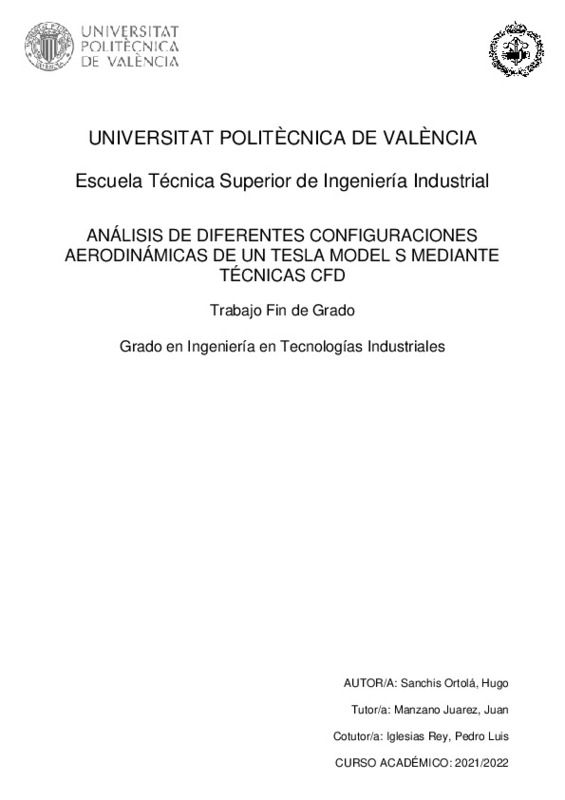JavaScript is disabled for your browser. Some features of this site may not work without it.
Buscar en RiuNet
Listar
Mi cuenta
Estadísticas
Ayuda RiuNet
Admin. UPV
ANÁLISIS DE DIFERENTES CONFIGURACIONES AERODINÁMICAS DE UN TESLA MODEL S MEDIANTE TÉCNICAS CFD
Mostrar el registro sencillo del ítem
Ficheros en el ítem
| dc.contributor.advisor | Manzano Juarez, Juan
|
es_ES |
| dc.contributor.advisor | Iglesias Rey, Pedro Luis
|
es_ES |
| dc.contributor.author | Sanchis Ortolá, Hugo
|
es_ES |
| dc.date.accessioned | 2022-11-09T16:49:49Z | |
| dc.date.available | 2022-11-09T16:49:49Z | |
| dc.date.created | 2022-09-09 | |
| dc.date.issued | 2022-11-09 | es_ES |
| dc.identifier.uri | http://hdl.handle.net/10251/189528 | |
| dc.description.abstract | [ES] Hoy en día, es bien sabida la gran importancia que posee la aerodinámica de un vehículo en aspectos como el rendimiento, consumo del motor, o la aceleración del mismo. Por ello, el presente trabajo final de grado se centra en el estudio y análisis de la influencia que tiene la implantación de un alerón trasero en la aerodinámica de un Tesla Model S, con el objetivo de obtener la inclinación optima de funcionamiento de dicho elemento. Para ello, se necesita un archivo CAD del vehículo y un programa de elementos finitos con el que, mediante simulaciones, se calculen las fuerzas que actúan sobre el vehículo. Partiendo de un modelo CAD del vehículo, se realizan modificaciones con el programa SolidWorks®, de tal modo que, sin perder la esencia del vehículo, se consigue un modelo simplificado que se adapta a ANSYS®, que es el programa de simulación a utilizar. Una vez introducida la geometría en ANSYS®, primero se crea un cubo de aire al que se le resta el volumen del vehículo, obteniendo así la geometría final. Posteriormente, se realiza el mallado, previamente de haber realizado un estudio de la malla para ver la influencia del tamaño de esta en el resultado. Con la geometría mallada, definiendo las condiciones de contorno, se realiza la simulación en ANSYS Fluent®, del que se obtienen las fuerzas que actúan sobre el vehículo y los coeficientes aerodinámicos. Con estos datos, se observa y compara las velocidades alcanzadas con cada configuración del alerón. De la misma forma, se ve el tiempo que tarda el vehículo en hacer una vuelta en un circuito, pudiendo llegar a la conclusión de que configuración aerodinámica es la óptima. | es_ES |
| dc.description.abstract | [EN] Nowadays, is very well known the importance of the aerodynamics of a vehicle in aspects such as performance, engine consumption, or acceleration. For this reason, this final degree project focuses on the study and analysis of the influence that the implementation of a rear wing has on the aerodynamics of a Tesla Model S, with the aim of obtaining the optimal operating inclination of said element. This requires a CAD file of the vehicle and a finite element program with which, through simulations, the forces acting on the vehicle are calculated. Starting from a CAD model of the vehicle, modifications are made with the SolidWorks® program, in such a way that, without losing the essence of the vehicle, a simplified model that adapts to ANSYS®, which is the simulation program to be used, is obtained. Once the geometry is exported to ANSYS®, to obtain the final geometry, a cube of air is created from which the volume of the vehicle is subtracted. Then, the meshing is done, having previously made a study of the mesh to see the influence of its size on the result. With the meshed geometry, defining the boundary conditions, the simulation is performed in ANSYS Fluent®, from which the forces acting on the vehicle and the aerodynamic coefficients are obtained. With these data, the speeds achieved with each rear wing configuration are observed and compared. In the same way, the time it takes for the vehicle to make a lap on a circuit is seen, being able to reach the conclusion of which aerodynamic configuration is the optimal. | es_ES |
| dc.format.extent | 165 | es_ES |
| dc.language | Español | es_ES |
| dc.publisher | Universitat Politècnica de València | es_ES |
| dc.rights | Reserva de todos los derechos | es_ES |
| dc.subject | Aerodinámica | es_ES |
| dc.subject | CFD | es_ES |
| dc.subject | Alerón trasero | es_ES |
| dc.subject.classification | MECANICA DE FLUIDOS | es_ES |
| dc.subject.classification | INGENIERIA HIDRAULICA | es_ES |
| dc.subject.other | Grado en Ingeniería en Tecnologías Industriales-Grau en Enginyeria en Tecnologies Industrials | es_ES |
| dc.title | ANÁLISIS DE DIFERENTES CONFIGURACIONES AERODINÁMICAS DE UN TESLA MODEL S MEDIANTE TÉCNICAS CFD | es_ES |
| dc.title.alternative | ANALYSIS OF DIFFERENT AERODYNAMIC CONFIGURATIONS OF A TESLA MODEL S USING CFD TECHNIQUES | es_ES |
| dc.title.alternative | ANÀLISI DE DIFERENTS CONFIGURACIONS AERODINÀMIQUES D'UN TESLA MODEL S MITJANÇANT TÈCNIQUES CFD | es_ES |
| dc.type | Proyecto/Trabajo fin de carrera/grado | es_ES |
| dc.rights.accessRights | Abierto | es_ES |
| dc.contributor.affiliation | Universitat Politècnica de València. Departamento de Ingeniería Hidráulica y Medio Ambiente - Departament d'Enginyeria Hidràulica i Medi Ambient | es_ES |
| dc.contributor.affiliation | Universitat Politècnica de València. Escuela Técnica Superior de Ingenieros Industriales - Escola Tècnica Superior d'Enginyers Industrials | es_ES |
| dc.description.bibliographicCitation | Sanchis Ortolá, H. (2022). ANÁLISIS DE DIFERENTES CONFIGURACIONES AERODINÁMICAS DE UN TESLA MODEL S MEDIANTE TÉCNICAS CFD. Universitat Politècnica de València. http://hdl.handle.net/10251/189528 | es_ES |
| dc.description.accrualMethod | TFGM | es_ES |
| dc.relation.pasarela | TFGM\150886 | es_ES |
Este ítem aparece en la(s) siguiente(s) colección(ones)
-
ETSII - Trabajos académicos [9864]
Escuela Técnica Superior de Ingenieros Industriales






